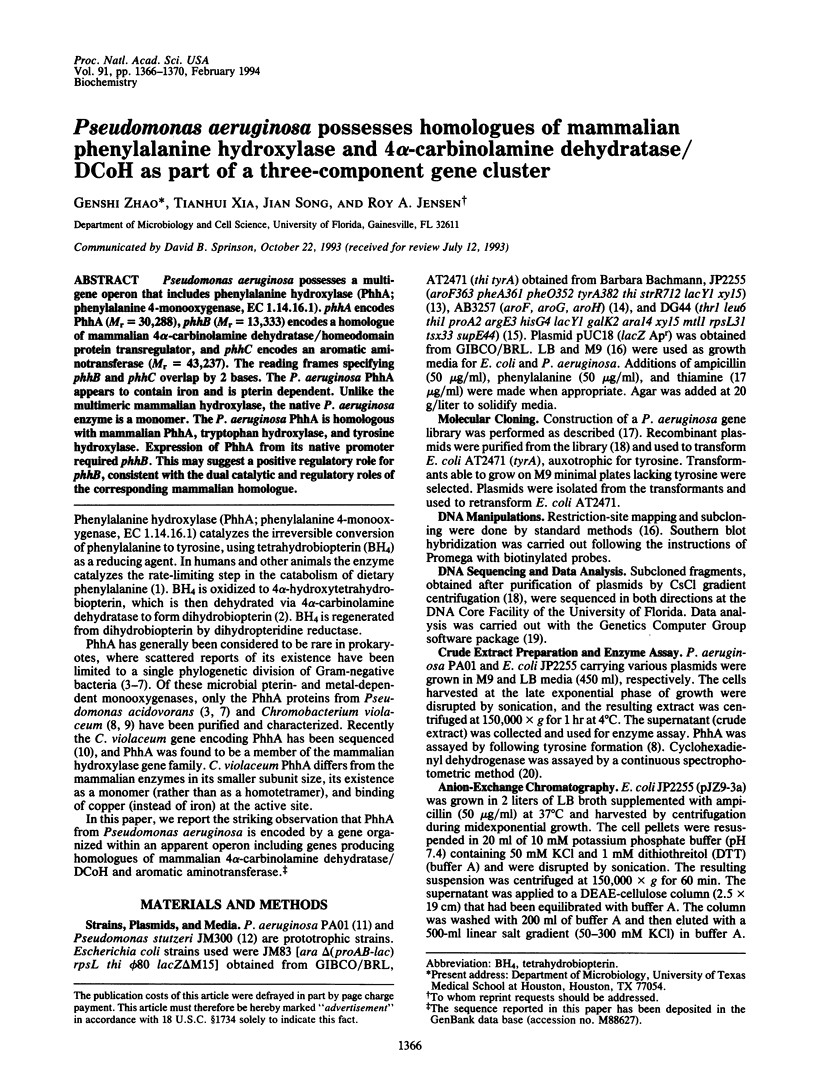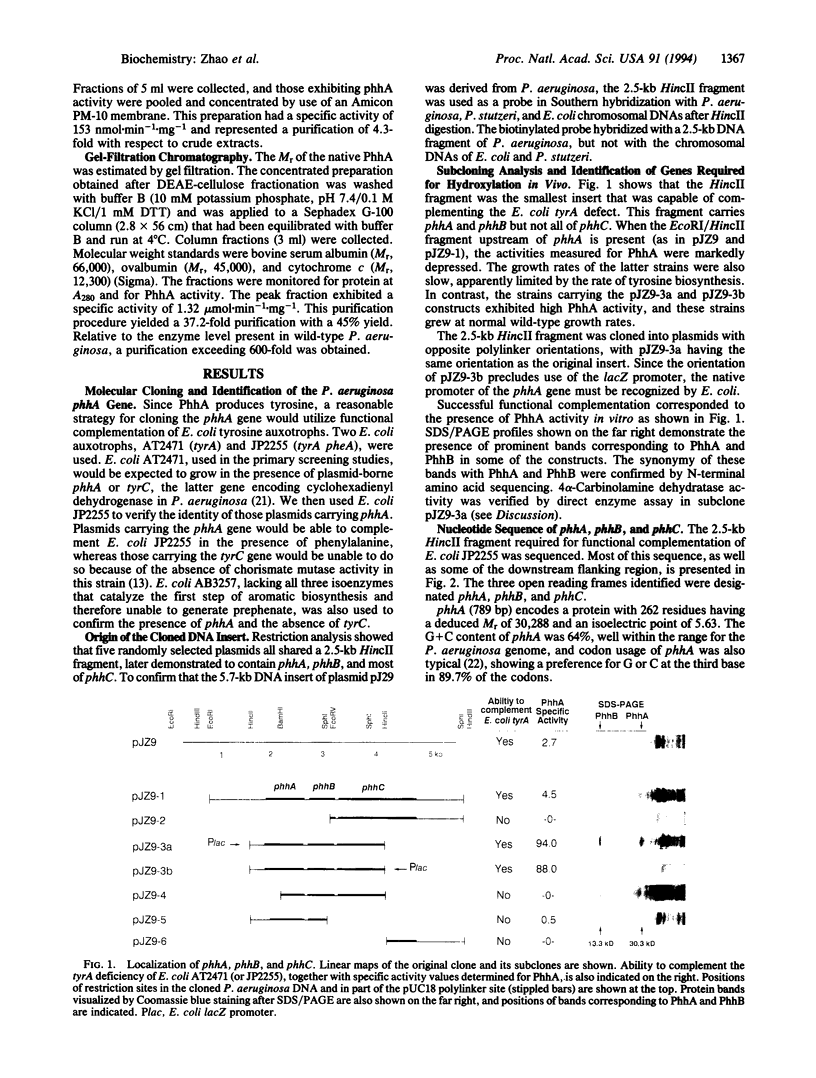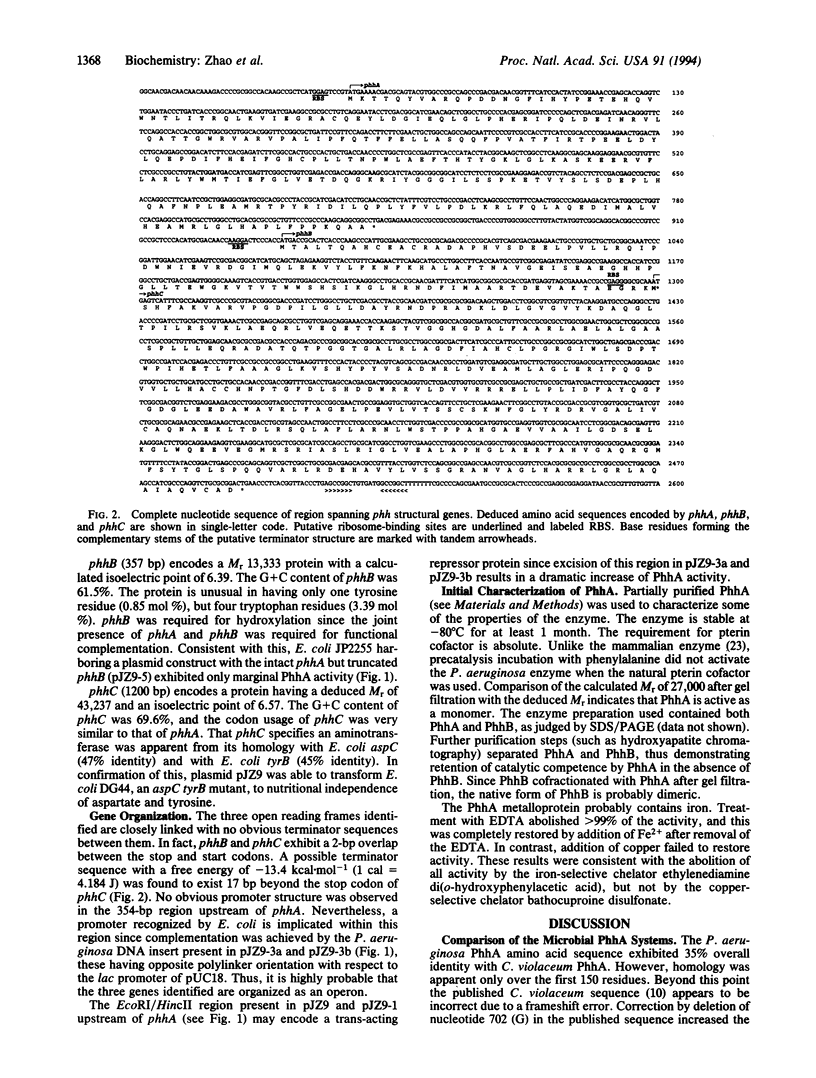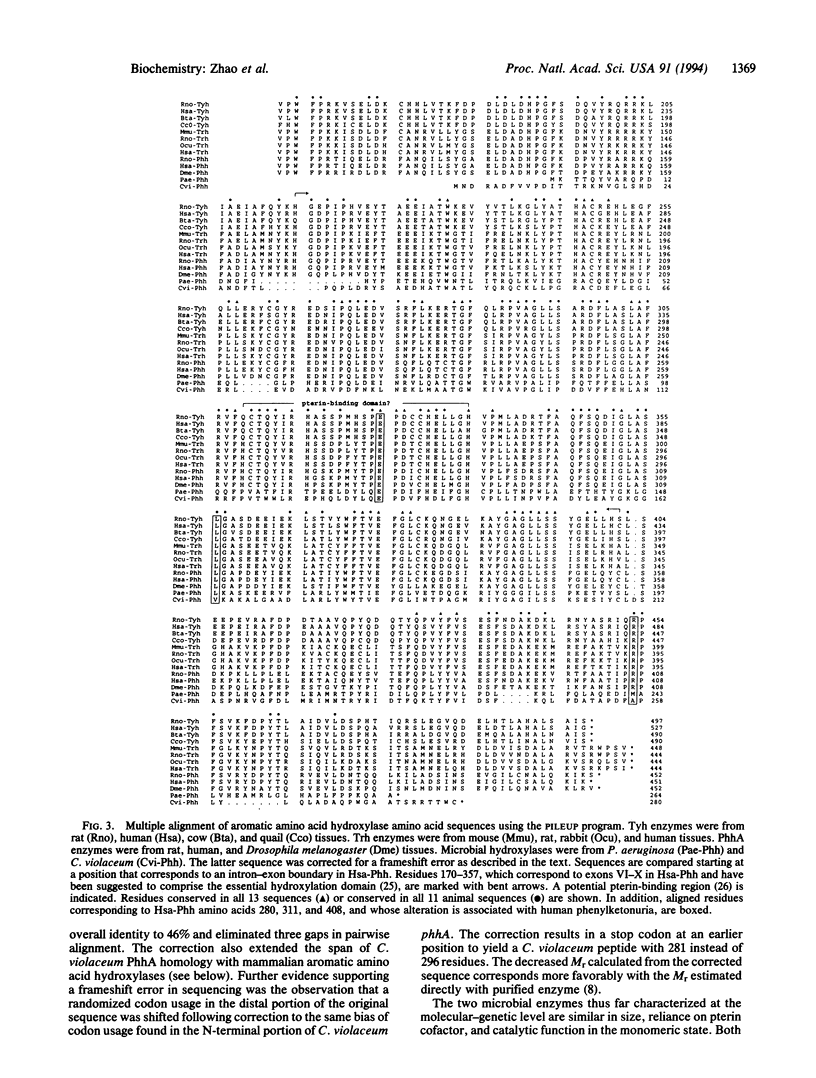Abstract
Pseudomonas aeruginosa possesses a multigene operon that includes phenylalanine hydroxylase (PhhA; phenylalanine 4-monooxygenase, EC 1.14.16.1). phhA encodes PhhA (M(r) = 30,288), phhB (M(r) = 13,333) encodes a homologue of mammalian 4 alpha-carbinolamine dehydratase/homeodomain protein transregulator, and phhC encodes an aromatic aminotransferase (M(r) = 43,237). The reading frames specifying phhB and phhC overlap by 2 bases. The P. aeruginosa PhhA appears to contain iron and is pterin dependent. Unlike the multimeric mammalian hydroxylase, the native P. aeruginosa enzyme is a monomer. The P. aeruginosa PhhA is homologous with mammalian PhhA, tryptophan hydroxylase, and tyrosine hydroxylase. Expression of PhhA from its native promoter required phhB. This may suggest a positive regulatory role for phhB, consistent with the dual catalytic and regulatory roles of the corresponding mammalian homologue.
Full text
PDF




Images in this article
Selected References
These references are in PubMed. This may not be the complete list of references from this article.
- Baldwin G. S., Davidson B. E. A kinetic and structural comparison of chorismate mutase/prephenate dehydratase from mutant strains of Escherichia coli K 12 defective in the PheA gene. Arch Biochem Biophys. 1981 Oct 1;211(1):66–75. doi: 10.1016/0003-9861(81)90430-6. [DOI] [PubMed] [Google Scholar]
- Berry A., Johnson J. L., Jensen R. A. Phenylalanine hydroxylase and isozymes of 3-deoxy-D-arabino-heptulosonate 7-phosphate synthase in relationship to the phylogenetic position of Pseudomonas acidovorans (Ps. sp. ATCC 11299a). Arch Microbiol. 1985 Feb;141(1):32–39. doi: 10.1007/BF00446736. [DOI] [PubMed] [Google Scholar]
- Bonner C., Jensen R. Arogenate dehydrogenase. Methods Enzymol. 1987;142:488–494. doi: 10.1016/s0076-6879(87)42060-0. [DOI] [PubMed] [Google Scholar]
- Carlson C. A., Pierson L. S., Rosen J. J., Ingraham J. L. Pseudomonas stutzeri and related species undergo natural transformation. J Bacteriol. 1983 Jan;153(1):93–99. doi: 10.1128/jb.153.1.93-99.1983. [DOI] [PMC free article] [PubMed] [Google Scholar]
- Citron B. A., Davis M. D., Milstien S., Gutierrez J., Mendel D. B., Crabtree G. R., Kaufman S. Identity of 4a-carbinolamine dehydratase, a component of the phenylalanine hydroxylation system, and DCoH, a transregulator of homeodomain proteins. Proc Natl Acad Sci U S A. 1992 Dec 15;89(24):11891–11894. doi: 10.1073/pnas.89.24.11891. [DOI] [PMC free article] [PubMed] [Google Scholar]
- DECICCO B. T., UMBREIT W. W. UTILIZATION OF AROMATIC AMINO ACIDS BY HYDROGENOMONAS FACILIS. J Bacteriol. 1964 Dec;88:1590–1594. doi: 10.1128/jb.88.6.1590-1594.1964. [DOI] [PMC free article] [PubMed] [Google Scholar]
- Dahl H. H., Mercer J. F. Isolation and sequence of a cDNA clone which contains the complete coding region of rat phenylalanine hydroxylase. Structural homology with tyrosine hydroxylase, glucocorticoid regulation, and use of alternate polyadenylation sites. J Biol Chem. 1986 Mar 25;261(9):4148–4153. [PubMed] [Google Scholar]
- Davis M. D., Ribeiro P., Tipper J., Kaufman S. "7-tetrahydrobiopterin," a naturally occurring analogue of tetrahydrobiopterin, is a cofactor for and a potential inhibitor of the aromatic amino acid hydroxylases. Proc Natl Acad Sci U S A. 1992 Nov 1;89(21):10109–10113. doi: 10.1073/pnas.89.21.10109. [DOI] [PMC free article] [PubMed] [Google Scholar]
- Friedrich B., Schlegel H. G. Die Hydroxylierung von Phenylalanin durch Hydrogenomanas eutropha H16. Arch Mikrobiol. 1972;83(1):17–31. [PubMed] [Google Scholar]
- GUROFF G., ITO T. INDUCED, SOLUBLE PHENYLALANINE HYDROXYLASE FROM PSEUDOMONAS SP. GROWN ON PHENYLALANINE OR TYROSINE. Biochim Biophys Acta. 1963 Sep 3;77:159–161. doi: 10.1016/0006-3002(63)90485-2. [DOI] [PubMed] [Google Scholar]
- Gelfand D. H., Steinberg R. A. Escherichia coli mutants deficient in the aspartate and aromatic amino acid aminotransferases. J Bacteriol. 1977 Apr;130(1):429–440. doi: 10.1128/jb.130.1.429-440.1977. [DOI] [PMC free article] [PubMed] [Google Scholar]
- HOLLOWAY B. W. Genetic recombination in Pseudomonas aeruginosa. J Gen Microbiol. 1955 Dec;13(3):572–581. doi: 10.1099/00221287-13-3-572. [DOI] [PubMed] [Google Scholar]
- Hauer C. R., Rebrin I., Thöny B., Neuheiser F., Curtius H. C., Hunziker P., Blau N., Ghisla S., Heizmann C. W. Phenylalanine hydroxylase-stimulating protein/pterin-4 alpha-carbinolamine dehydratase from rat and human liver. Purification, characterization, and complete amino acid sequence. J Biol Chem. 1993 Mar 5;268(7):4828–4831. [PubMed] [Google Scholar]
- Humphreys G. O., Willshaw G. A., Anderson E. S. A simple method for the preparation of large quantities of pure plasmid DNA. Biochim Biophys Acta. 1975 Apr 2;383(4):457–463. doi: 10.1016/0005-2787(75)90318-4. [DOI] [PubMed] [Google Scholar]
- Jennings I. G., Kemp B. E., Cotton R. G. Localization of cofactor binding sites with monoclonal anti-idiotype antibodies: phenylalanine hydroxylase. Proc Natl Acad Sci U S A. 1991 Jul 1;88(13):5734–5738. doi: 10.1073/pnas.88.13.5734. [DOI] [PMC free article] [PubMed] [Google Scholar]
- Kaufman S. Phenylalanine 4-monooxygenase from rat liver. Methods Enzymol. 1987;142:3–17. doi: 10.1016/s0076-6879(87)42003-x. [DOI] [PubMed] [Google Scholar]
- Letendre C. H., Dickens G., Guroff G. The tryptophan hydroxylase of Chromobacterium violaceum. J Biol Chem. 1974 Nov 25;249(22):7186–7191. [PubMed] [Google Scholar]
- Morales G., Requena J. M., Jimenez-Ruiz A., Lopez M. C., Ugarte M., Alonso C. Sequence and expression of the Drosophila phenylalanine hydroxylase mRNA. Gene. 1990 Sep 14;93(2):213–219. doi: 10.1016/0378-1119(90)90227-i. [DOI] [PubMed] [Google Scholar]
- Nakata H., Yamauchi T., Fujisawa H. Phenylalanine hydroxylase from Chromobacterium violaceum. Purification and characterization. J Biol Chem. 1979 Mar 25;254(6):1829–1833. [PubMed] [Google Scholar]
- Onishi A., Liotta L. J., Benkovic S. J. Cloning and expression of Chromobacterium violaceum phenylalanine hydroxylase in Escherichia coli and comparison of amino acid sequence with mammalian aromatic amino acid hydroxylases. J Biol Chem. 1991 Oct 5;266(28):18454–18459. [PubMed] [Google Scholar]
- Pember S. O., Villafranca J. J., Benkovic S. J. Phenylalanine hydroxylase from Chromobacterium violaceum is a copper-containing monooxygenase. Kinetics of the reductive activation of the enzyme. Biochemistry. 1986 Oct 21;25(21):6611–6619. doi: 10.1021/bi00369a042. [DOI] [PubMed] [Google Scholar]
- Wallace B. J., Pittard J. Regulation of 3-deoxy-D-arabino-heptulosonic 7-phosphate acid synthetase activity in relation to the synthesis of the aromatic vitamins in Escherichia coli K-12. J Bacteriol. 1969 Sep;99(3):707–712. doi: 10.1128/jb.99.3.707-712.1969. [DOI] [PMC free article] [PubMed] [Google Scholar]
- West S. E., Iglewski B. H. Codon usage in Pseudomonas aeruginosa. Nucleic Acids Res. 1988 Oct 11;16(19):9323–9335. doi: 10.1093/nar/16.19.9323. [DOI] [PMC free article] [PubMed] [Google Scholar]
- Xia T. H., Jensen R. A. A single cyclohexadienyl dehydrogenase specifies the prephenate dehydrogenase and arogenate dehydrogenase components of the dual pathways to L-tyrosine in Pseudomonas aeruginosa. J Biol Chem. 1990 Nov 15;265(32):20033–20036. [PubMed] [Google Scholar]
- Zhao G. S., Xia T. H., Fischer R. S., Jensen R. A. Cyclohexadienyl dehydratase from Pseudomonas aeruginosa. Molecular cloning of the gene and characterization of the gene product. J Biol Chem. 1992 Feb 5;267(4):2487–2493. [PubMed] [Google Scholar]



